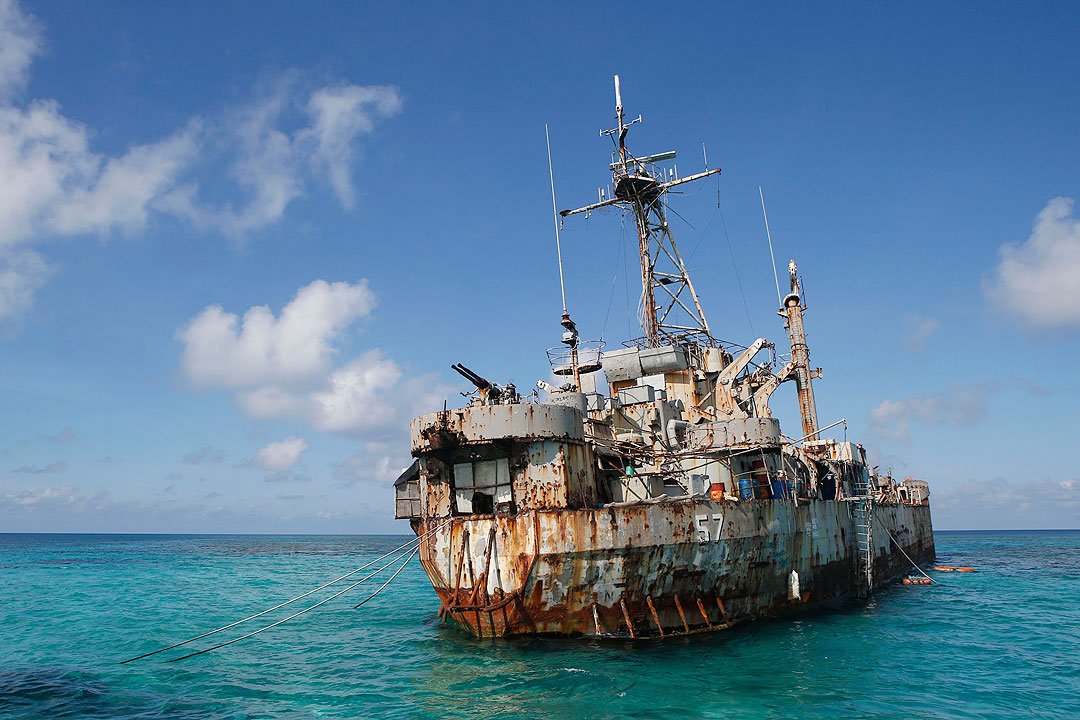South China Sea: Why are China and Philippines tensions heating up?

MANILA – An escalating diplomatic row and recent maritime run-ins between China and the Philippines, a US treaty ally, have made the highly strategic South China Sea a potential flashpoint between Washington and Beijing.
The issue will be a focus of trilateral meeting between US President Joe Biden, Philippines President Ferdinand Marcos Jr. and Japan Prime Minister Fumio Kishida in Washington on Thursday.
WHAT ARE THE FLASHPOINTS?
Central to recent standoffs between the Philippines and China are two hotly contested features located inside Manila’s 200-nautical mile exclusive economic zone, but which Beijing claims as its own.
China uses the so-called nine-dash line that takes in about 90% of the South China Sea to assert its claim to sovereignty over the Scarborough Shoal, a submerged reef coveted for its bountiful fish stocks, and the Second Thomas Shoal, home to a small contingent of Filipino sailors living aboard a rusty warship that Manila intentionally grounded in 1999 to further its territorial claims.
WHY ARE THINGS HEATING UP?
The Permanent Court of Arbitration in the Hague ruled in 2016 that Beijing’s expansive claims via its nine-dash line had no basis under international law, handing the Philippines a landmark victory, but that has not stopped China, which rejects the ruling, from being more assertive.
Beijing has deployed hundreds of coastguard vessels to patrol those areas, alarming the Philippines, rival claimants and other states operating in the South China Sea, including the United States, which is wary about China’s growing military power and territorial ambition.
WHAT HAVE THE STANDOFFS ENTAILED?
Encounters between the Philippines and China in Asia’s most contested waters have grown tenser and more frequent over the past year as Beijing presses its claims and Manila refuses to cease its fishing and resupply activities to Filipinos at the two shoals. China considers those to be illegal intrusions and has tried to repel the vessels.
China’s coastguard has stepped up so-called “grey-zone” activities such as use of water cannon, collision and ramming tactics, and, according to Manila, use of a military-grade laser, to try to stop the Philippine resupply and patrol missions. It has also deployed an armada of fishing boats the Philippines and allies consider militia.
During the last two Second Thomas Shoal resupply missions, Philippine boats sustained damage and some crew were injured after use of water cannon. China has urged the Philippines to tow away the warship, saying it had promised to do just that, but Manila maintains no such agreement was made.
WHAT WAS THE GLOBAL REACTION?
China’s actions have drawn international condemnation and concern from major powers including the United States, Japan, Australia, France, and Britain.
Foreign journalists have joined some of the Philippine resupply missions and documented events at the invitation of the Philippines, which one security official said was aimed at “shedding light on China’s ‘grey zone’ tactics”. China has accused the Philippines of stirring up trouble and spreading misinformation.
China’s actions are “dangerous, illegal and they are destabilizing the region,” a senior US admiral said on April 9.
HOW IS THE PHILIPPINES RESPONDING?
President Ferdinand Marcos Jr has adopted a tough line against what he sees as Chinese hostility and rejected its pressure, recently vowing to implement countermeasures against “illegal, coercive, aggressive, and dangerous attacks” by China’s coastguard, upping the ante in the escalating row.
The Philippines has said countermeasures will be “multi-dimensional” and involve exhausting diplomatic options. Mr. Marcos has also called for stronger coordination on maritime security to confront “a range of serious challenges” to territorial integrity and peace.
COULD THE UNITED STATES GET INVOLVED?
The Philippines’ dispute with China coincides with an increase in security engagements with the United States under Mr. Marcos, including expansion of U.S. access to Philippine bases. Manila is also seeking close security ties with other allies like Japan and Australia. The engagements include joint patrols, which have frustrated China.
The United States has a Mutual Defense Treaty with the Philippines and has repeatedly made clear it would protect its ally if its coastguard or armed forces came under attack anywhere in the South China Sea, calling the agreement “ironclad”.
The treaty raises the stakes significantly in the Philippines-China dispute in the event of a miscalculation at sea. However, it could also limit how far China is willing to go to keep the Philippines at bay, wary of the risks of conflict and pressure to respond resolutely if there were direct US military involvement.
Philippine officials, including Marcos, have dismissed talk of invoking the treaty in the present situation, stressing it would be a last resort. – Reuters
